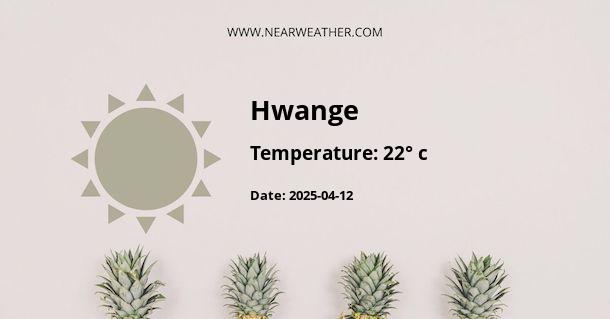Hwange, Zimbabwe: Climate and Weather Year Round
Hwange is a picturesque town located in the western part of Zimbabwe, known for its stunning natural beauty and diverse wildlife. The climate in Hwange is classified as a semi-arid climate, with distinct wet and dry seasons. Understanding the weather patterns and conditions in Hwange throughout the year is essential for visitors and locals alike. In this article, we will explore the climate and weather in Hwange, Zimbabwe, and provide detailed information about the different seasons and their characteristics.
1. Summer Season (October to March)
The summer season in Hwange, Zimbabwe, begins in October and lasts until March, bringing high temperatures and occasional rainfall. During this period, the average daytime temperature ranges from 30°C to 35°C (86°F to 95°F), making it quite hot. The nights, however, are relatively cooler, with temperatures dropping to around 18°C to 22°C (64°F to 72°F).
Rainfall is more frequent during the summer season, with December and January being the wettest months. The average monthly precipitation during this period ranges from 50mm to 100mm (2 inches to 4 inches). These rainfall patterns contribute to the lush greenery and vibrant vegetation, making it an ideal time for wildlife enthusiasts and nature lovers to visit Hwange National Park.
It is worth noting that the summer season coincides with the migration of many bird species to Hwange, making it a paradise for birdwatchers. Additionally, the increased water availability attracts a variety of wildlife, including elephants, lions, and buffalo, making it an excellent time for game drives and safaris.
2. Autumn Season (April to May)
The autumn season in Hwange, Zimbabwe, occurs from April to May and is characterized by milder temperatures and decreasing rainfall. The average daytime temperature during this period ranges from 27°C to 32°C (81°F to 90°F), gradually becoming cooler as the season progresses.
Rainfall decreases significantly, with April experiencing some sporadic showers and May being relatively dry. The average monthly precipitation during this period ranges from 10mm to 30mm (0.4 inches to 1.2 inches). The landscape begins to dry out, and the vegetation starts to lose its vibrant green color.
Autumn is an excellent time to visit Hwange for those who prefer slightly cooler temperatures and quieter wildlife sightings. It is a transitional period between the wet and dry seasons, offering a unique blend of both.
3. Winter Season (June to August)
The winter season in Hwange, Zimbabwe, lasts from June to August and is characterized by mild to cool temperatures and dry conditions. The average daytime temperature ranges from 20°C to 25°C (68°F to 77°F), while the nights can be quite chilly, with temperatures dropping to around 8°C to 12°C (46°F to 54°F).
Rainfall is minimal during the winter season, with June being the driest month. The average monthly precipitation during this period ranges from 0mm to 10mm (0 inches to 0.4 inches). The landscape becomes dry and barren, and the vegetation turns brown, creating a stark contrast to the lushness of the summer season.
Despite the dry conditions, wildlife sightings are still abundant during winter, as animals gather around waterholes and rivers. It is an excellent time for game drives and safaris, as the lack of foliage allows for better visibility and the concentration of wildlife around water sources makes for exciting encounters.
4. Spring Season (September)
The spring season in Hwange, Zimbabwe, occurs in September and is a transitional period between the dry and wet seasons. The average daytime temperature starts to rise again, ranging from 25°C to 30°C (77°F to 86°F), while the nights remain relatively cool.
Rainfall begins to increase towards the end of the spring season, with September receiving some sporadic showers. The average monthly precipitation during this period ranges from 10mm to 30mm (0.4 inches to 1.2 inches). The landscape slowly starts to rejuvenate, and the vegetation regains its green color.
Spring is an excellent time to visit Hwange for those who enjoy milder temperatures and the beauty of nature coming back to life. It is also a time when many migratory bird species start their journey back to their breeding grounds.
Conclusion
Hwange, Zimbabwe, experiences a semi-arid climate with distinct wet and dry seasons. The summer season brings high temperatures and occasional rainfall, making it an ideal time for wildlife enthusiasts and birdwatchers. Autumn offers milder temperatures and decreasing rainfall, providing a transitional period between the wet and dry seasons. Winter brings mild to cool temperatures and dry conditions, with excellent wildlife sightings around water sources. Spring is a time of rejuvenation, with rising temperatures and increasing rainfall, making it a beautiful season to witness nature coming back to life.
Whether you prefer the lushness of the wet season or the dry landscapes of the dry season, Hwange offers a unique and diverse climate throughout the year, making it a captivating destination for nature lovers and adventure seekers.
A - Hwange's Latitude is -18.369270 & Longitude is 26.501940.
A - Weather in Hwange is 22° today.
A - Climate Conditions in Hwange shows scattered clouds today.
A - Humidity in Hwange is 68% today.
A - Wind speed in Hwange is 8.32 km/h, flowing at 109° wind direction. today.
